Are you looking to maximize your living space without breaking the bank? Converting a garage into a mini apartment could be the perfect solution. Not only does it provide an affordable option for adding extra living space, but it also allows you to utilize an often-underutilized area of your home. Whether you need a guest suite, a home office, or a cozy apartment for yourself, a garage conversion can offer many possibilities.
Converting a garage into a mini apartment is a recently popular space-saving solution. With creativity and proper planning, you can transform your dusty garage into a stylish and functional living space that meets your unique needs.
One of the key benefits of converting a garage is the cost savings compared to traditional home additions. Since the basic structure and foundation already exist, the major expenses are generally limited to insulation, plumbing, electrical work, and interior finishes. This makes it a cost-effective option for homeowners on a budget.
Additionally, repurposing your garage into a mini apartment offers the flexibility to customize the space according to your specific requirements. You can design a studio-style apartment with a living area, kitchenette, and bathroom or create a separate bedroom with a cozy nook and ample storage. The versatility of a garage conversion allows you to personalize the space to suit your lifestyle and preferences.
Furthermore, converting a garage into a mini apartment adds value to your property. It enhances your options for comfortable living and increases the potential resale value. As more people seek alternative living arrangements and flexible spaces, a well-designed and adequately executed garage conversion can be an attractive feature for potential buyers.
The Benefits of Converting a Garage into a Mini Apartment
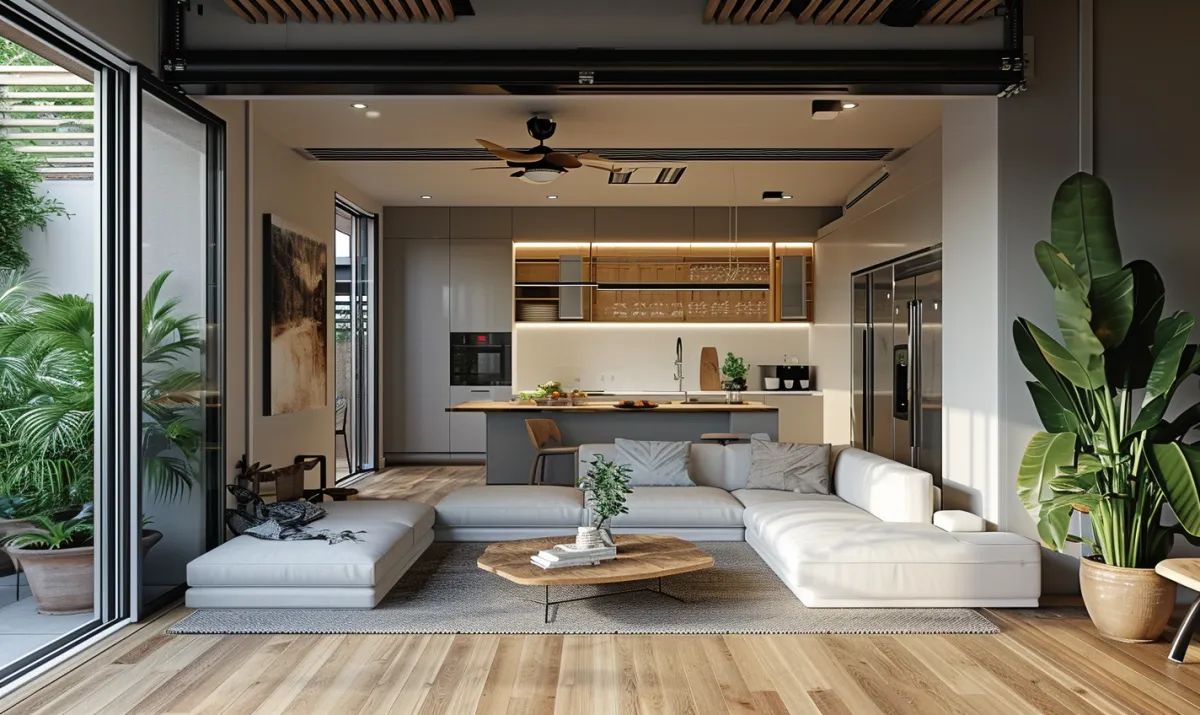
Have you ever considered utilizing the underutilized space in your garage? Converting a garage into a mini apartment can provide numerous benefits that add value to your property and enhance your lifestyle. Let’s take a closer look at some of the advantages of this transformation:
1. Increased Living Space
By converting your garage into a mini apartment, you’re essentially adding an extra living area to your home. This additional space can serve various purposes, such as accommodating a family member, creating a home office, or generating rental income. It allows you to make the most of your property’s square footage.
2. Cost-Effective Solution
Compared to building a brand-new addition, converting a garage is a cost-effective alternative. The existing structure and foundation are already in place, reducing construction expenses significantly. This way, you can transform your garage into a livable space without breaking the bank.
3. Increased Property Value
A well-executed garage conversion can significantly boost the value of your property. The additional living space adds appeal to potential buyers, making your property stand out in the real estate market. Whether you decide to sell your home in the future, converting your garage is a wise investment that increases its overall worth.
4. Flexibility in Design
Converting a garage allows you to unleash your creativity and design a unique space that suits your needs and preferences. The possibilities are endless, whether you prefer a contemporary studio apartment or a cozy guesthouse. Customizing the layout, decor, and functionality ensures the new mini apartment perfectly aligns with your lifestyle.
5. Reduced Environmental Impact
Repurposing an existing structure instead of constructing a new one helps reduce your environmental footprint. By converting your garage, you’re optimizing available resources while minimizing waste. Additionally, incorporating energy-efficient features in your mini apartment, such as solar panels or insulation, can reduce your carbon footprint and lower utility costs.
Converting a garage into a mini apartment presents a world of possibilities. It’s a cost-effective way to increase living space, add value to your property, and reduce environmental impact. So, why let your garage go unused when it can be transformed into a functional, stylish, and versatile living area that enhances your home and lifestyle?
Steps to Take Before Converting Your Garage
Converting a garage into a mini apartment is a great way to maximize your living space and add value to your home. Whether you plan to use it as a rental unit, a guest suite, or simply as an extra room for your family, you should take several essential steps before starting the conversion process.
1. Assess the Structural Integrity
Before diving into the conversion, it’s crucial to assess the structural integrity of your garage. Ensure the foundation is in good condition, check for any signs of water damage or pest infestation, and ensure the walls and roof are sturdy enough for the desired renovation.
2. Check Local Regulations and Permits
Converting a garage into a living space often requires obtaining the necessary permits from your local government. Check with your municipality to determine the specific regulations and requirements, as some areas restrict the size, height, and use of converted spaces.
3. Set a Realistic Budget
Converting a garage can be a significant investment, so setting a realistic budget before you begin is essential. Consider the costs of insulation, electrical work, plumbing, HVAC systems, flooring, and any additional features you plan to include in your mini apartment.
4. Plan the Layout and Design
Take the time to plan your mini apartment’s layout and design carefully. Consider the available space and maximize functionality while creating a comfortable and aesthetically pleasing living area. Consider placing walls, windows, doors, and furniture to create a cohesive and inviting space.
5. Hire a Professional Contractor
Unless you have extensive construction and design experience, hiring a professional contractor specializing in garage conversions is highly recommended. They will have the knowledge and expertise to ensure the project is completed safely, efficiently, and up to code.
6. Consider Utilities and Amenities
Don’t forget to plan for utilities and amenities when converting your garage into a mini apartment. Determine the best location for electrical outlets, plumbing fixtures, and HVAC systems to ensure comfort and functionality. Consider incorporating storage solutions, such as built-in cabinets or loft spaces, to optimize the use of space.
7. Plan for Safety and Security
When converting your garage into a living space, it’s essential to prioritize safety and security. Install proper lighting inside and outside the apartment, consider adding security features like alarm systems or surveillance cameras, and ensure all windows and doors are secure and meet safety standards.
By taking these steps before converting your garage, you’ll be well-prepared and equipped to successfully transform it into a functional and inviting mini apartment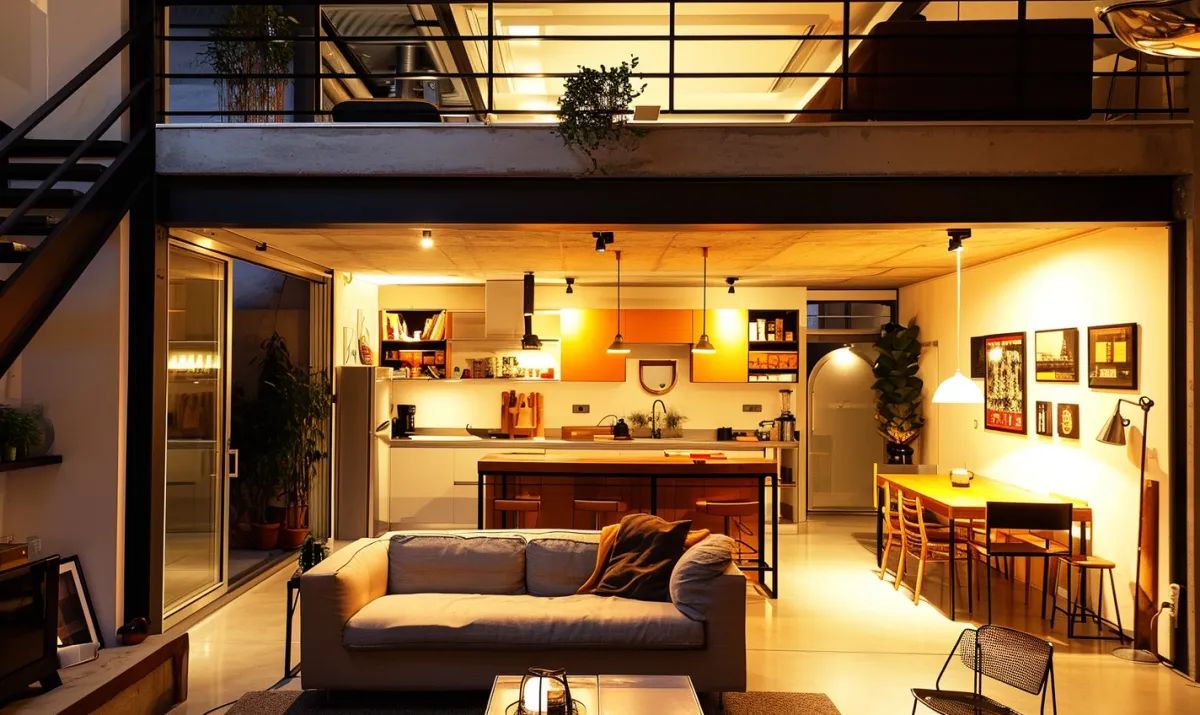 . Enjoy the process and make it a space you and your loved ones will enjoy.
. Enjoy the process and make it a space you and your loved ones will enjoy.
Finding Inspiration for Your Mini Apartment Design
Converting a garage into a mini apartment is an exciting project that allows you to maximize the potential of your space. Whether you’re looking to create a cozy guest suite, a home office, or a place for your young adult to live independently, the possibilities are endless. Finding inspiration for your mini apartment design is essential to ensure a successful transformation. Here are some tips to get your creative juices flowing:
1. Explore Online Resources
The internet is a treasure trove of inspiration for garage conversions. Visit websites and online platforms dedicated to home design and renovation projects. Browse through photos, articles, and forums for ideas and tips from homeowners who have already converted their garages into living spaces. Pinterest, Houzz, and Instagram are great platforms to discover visually appealing designs, color schemes, and clever storage solutions.
2. Visit Model Apartments and Showrooms
Taking a trip to model apartments and showrooms can provide immense inspiration for your mini apartment design. Many furniture and home decor stores set up beautifully staged rooms that can spark your creativity. Pay attention to how small spaces are optimized, and take note of the furniture arrangements, lighting fixtures, and color combinations that catch your eye.
3. Seek Inspiration from Tiny Homes
Tiny homes have become increasingly popular for their efficient use of space. These pint-sized dwellings are often designed to accommodate all the necessities of daily life. Explore tiny home blogs, magazines, and television shows to gather ideas that can be scaled down to fit your garage conversion. From multi-purpose furniture to clever storage solutions, there’s much to learn from this minimalistic lifestyle.
4. Consider Your Style and Needs
Your mini apartment should reflect your unique style and cater to your needs. Take some time to think about your preferences and how you envision the space. Are you drawn to modern aesthetics or prefer a more rustic feel? Do you need ample storage for your hobbies or a dedicated workspace for your home business? Understanding your requirements and personal taste will guide your design choices.
5. Consult with a Professional
If you’re feeling overwhelmed or unsure where to begin, don’t hesitate to seek guidance from a professional designer or architect. They can assist you in translating your vision into a functional and visually appealing mini apartment design.
By considering these sources of inspiration, you’ll be well on your way to creating a mini apartment that perfectly suits your needs and style. Remember, converting a garage into a mini apartment allows you to customize your space and make it your own.
Creating a Functional Layout for Your Garage Conversion
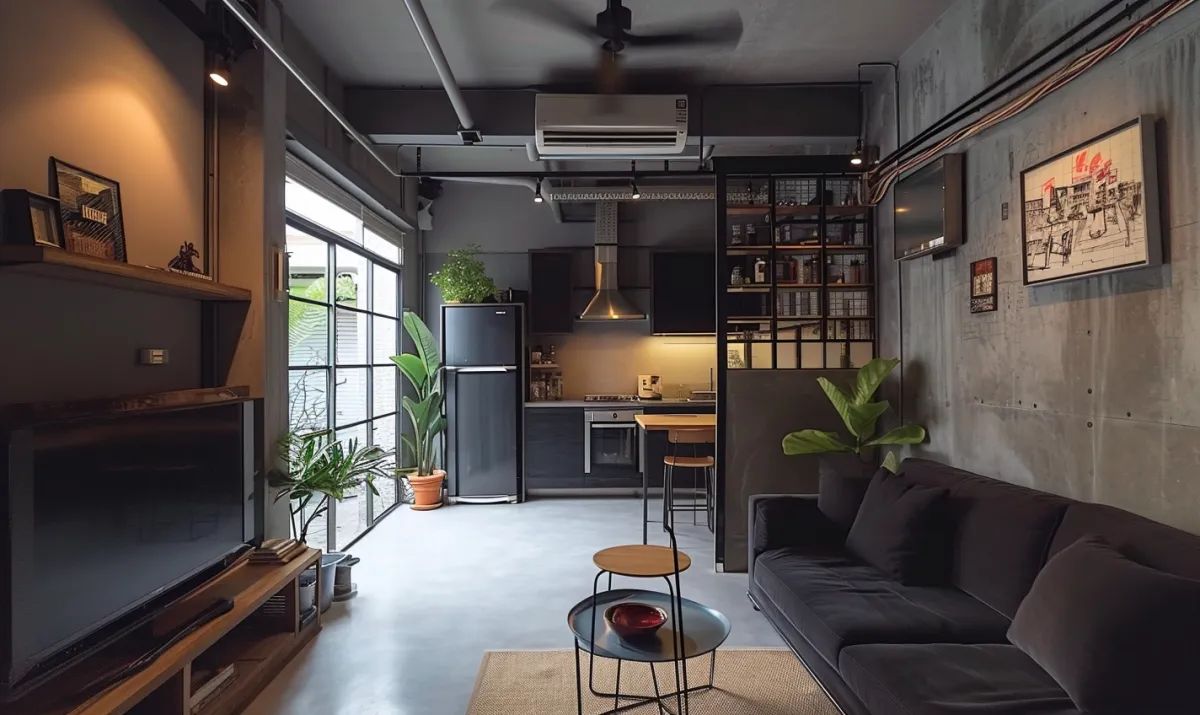
So, you’ve decided to convert your garage into a mini apartment. Now comes the fun part – designing a functional layout that maximizes the available space and meets your needs. Whether planning to create a cozy studio or a compact one-bedroom apartment, thoughtful planning is critical to ensuring your garage conversion is practical and aesthetically pleasing.
1. Define your living areas
Consider how you will use the space and create distinct living areas within your mini apartment. This may include a sleeping area, living room, kitchenette, and bathroom. Think about the flow of the space and how you can arrange furniture and fixtures to optimize functionality.
2. Utilize vertical space
Garages often have high ceilings, making them perfect for maximizing vertical space. Install tall storage units and shelving to organize your belongings and maximize every square inch. Hanging shelves or installing hooks on the walls can provide additional storage options while keeping the floor clear.
3. Consider multi-purpose furniture
Choosing furniture that serves multiple functions is essential in a small living space. Look for pieces that can be used as both storage and seating, such as ottomans with hidden compartments or sofa beds. This will help you make the most of limited space without sacrificing comfort or style.
4. Create visual separation
Even in an open-concept layout, creating a visual separation between different areas of your mini apartment is essential. This can be achieved by strategically placing furniture, area rugs, or room dividers. You’ll create a sense of organization and coziness by visually defining separate spaces.
5. Optimize natural light
Garages can sometimes lack natural light, so maximizing the sunlight entering your mini apartment is crucial. Consider installing skylights or more oversized windows to brighten up the space. Additionally, choose light-colored furnishings and décor to reflect light and create a sense of airiness.
6. Incorporate intelligent storage solutions
Storage is vital in any living space, especially in smaller ones. Consider innovative solutions like built-in shelves, under-bed storage, or hidden storage compartments. This will help you keep your mini apartment tidy and organized while minimizing clutter.
Remember, converting your garage into a mini apartment is a creative and exciting project that allows you to personalize your living space. By carefully considering the layout and making thoughtful design choices, you can transform your garage into a functional and stylish home where you’ll love living.
Choosing the Right Materials for Your Mini Apartment
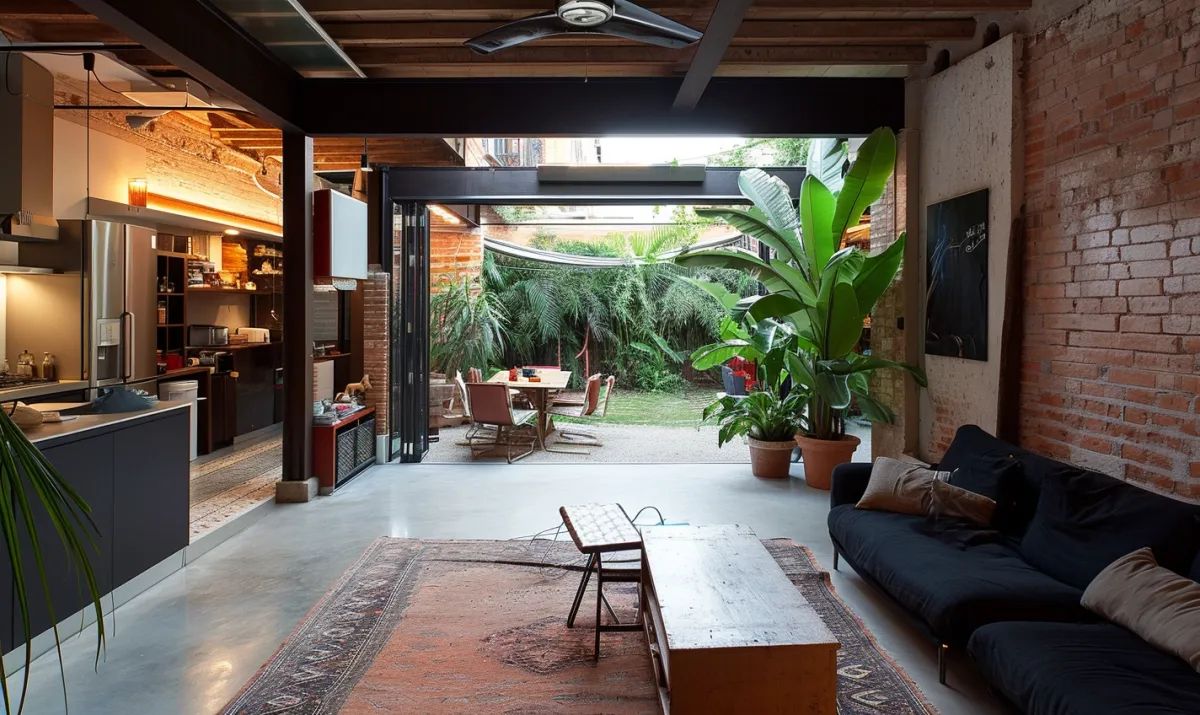
Choosing suitable materials is one of the most critical aspects when converting a garage into a mini apartment. The materials you select will determine your mini apartment’s overall look and feel and its durability, functionality, and comfort. Here are some key factors to consider when making your material selections:
Flooring:
One of the first things you’ll want to decide on is the type of flooring for your mini apartment. Consider options that are both durable and visually appealing. Some popular choices include:
- Hardwood: Adds a timeless and elegant touch to your space
- Laminate: Provides a cost-effective alternative to hardwood with a wide range of styles
- Title: Offers durability, easy maintenance, and endless design possibilities
- Vinyl: Known for its affordability, water resistance, and versatility
Walls:
The walls of your mini apartment can contribute significantly to its overall aesthetics. However, they also serve a functional purpose, such as insulation and soundproofing. Here are some options to consider:
- Drywall: A popular choice that can easily be painted or textured
- Paneling: Provides a rustic or contemporary look, depending on the style chosen
- Plaster: Offers a smooth and polished finish, ideal for a more sophisticated appeal
Windows:
Choosing the right windows for your mini apartment is crucial, as they can significantly impact the space’s natural light, ventilation, and energy efficiency. Consider the following options:
- Double-pane windows: Help reduce noise and increase energy efficiency
- Energy-efficient windows: Designed to minimize heat transfer and save on energy costs
- Skylights: Add natural light and can be opened for ventilation in limited space
Appliances and Fixtures:
Opt for compact and efficient appliances to make the most of your limited space for appliances and fixtures. Look for appliances labeled as “apartment-size” or “compact” to ensure they fit seamlessly into your mini apartment.
By carefully selecting the suitable materials, you can create a mini apartment that is visually appealing but also functional, comfortable, and sustainable. Consider your style, budget, and space’s specific needs to make informed material choices. Enjoy the process of transforming your garage into a cozy living space!
Maximizing Natural Light in Your Garage Conversion
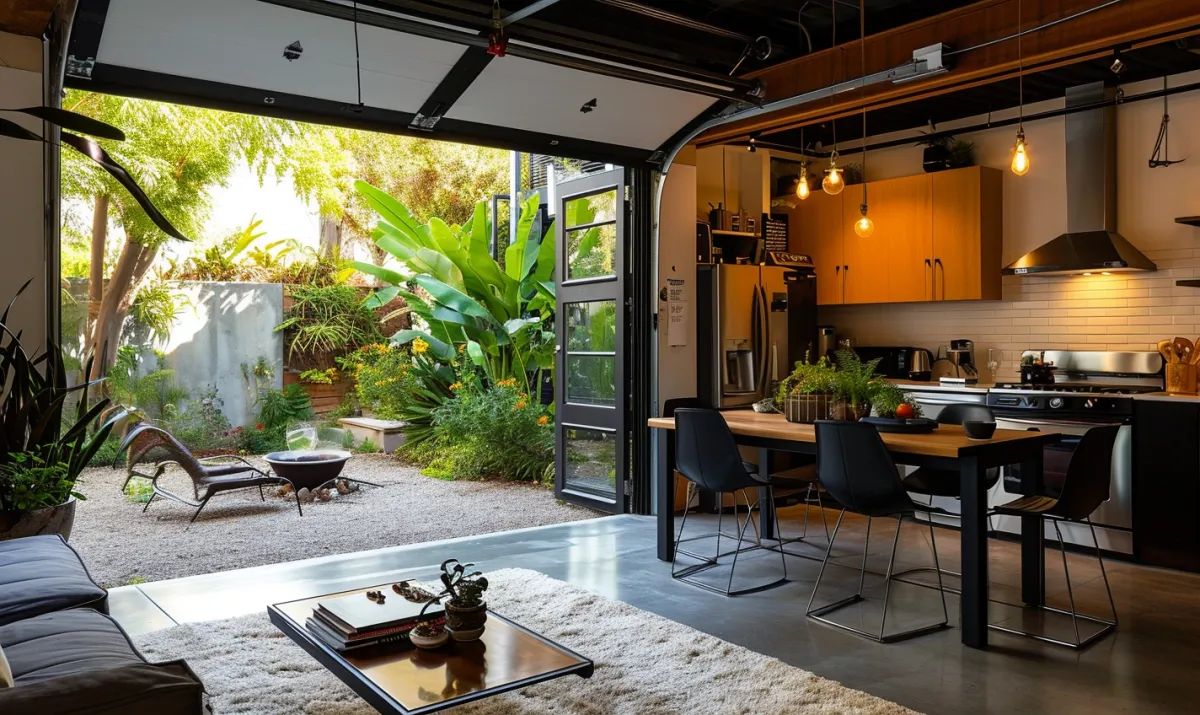
When converting a garage into a mini apartment, one of the critical considerations is maximizing natural light. Natural light not only enhances the overall aesthetics of your space but also has numerous benefits for your well-being. Here are some tips to help you bring in as much natural light as possible:
Install Larger Windows
Replacing small windows with larger ones can dramatically increase the amount of natural light in your garage conversion. Consider floor-to-ceiling windows or installing a bay window to flood the space with sunlight.
Add Skylights
Skylights are an excellent way to introduce additional natural light into your mini apartment. They allow light to enter from above, brightening the space and creating a sense of openness.
Use Light-Reflective Colors
Choose light-colored walls, ceilings, and flooring materials to maximize the natural light. Light colors reflect sunlight, making the space appear brighter and more spacious.
Opt for Translucent Window Treatments
Avoid heavy curtains or dark blinds that can block natural light. Instead, opt for translucent window treatments that allow light to filter through while maintaining privacy. Sheer curtains or light-filtering blinds are perfect choices.
Consider Light-Reflective Surfaces
Opt for light-reflective surfaces like glossy or semi-gloss paint, mirrored accents, or glass furniture. These surfaces bounce light around the room, making it brighter and more vibrant.
Remember, natural light improves the ambiance of your mini apartment and offers health benefits such as improved mood, increased productivity, and better sleep.
By following these tips and maximizing the natural light in your garage conversion, you can create a bright and inviting space that will be a joy to live in.
Insulating Your Garage for Optimal Comfort
Why is Insulation Important for Your Garage Conversion?
If you’re considering converting your garage into a mini apartment, one crucial aspect that should not be overlooked is insulation. Insulating your garage is essential for creating a comfortable living space that stays warm in the winter and cool in the summer. Additionally, insulation helps to reduce outside noise, making your mini apartment more peaceful and inviting.
The Benefits of Proper Insulation
By insulating your garage, you can enjoy several benefits:
- Improved energy efficiency: Insulation helps to regulate the temperature, reducing the need for excessive heating or cooling and saving you money on energy bills.
- Enhanced comfort: Insulation provides a barrier against extreme temperatures and drafts, ensuring that your mini apartment remains comfortable year-round.
- Noise reduction: Insulating materials help to absorb sound, creating a quieter living environment inside your mini apartment.
- Moisture control: Proper insulation prevents moisture buildup, reducing the risk of mold and mildew growth.
Types of Insulation for Your Garage Conversion
There are various types of insulation materials to consider for your garage conversion:
- Batt insulation: These pre-cut fiberglass or mineral wool panels are easy to install and provide excellent thermal and sound insulation.
- Spray foam insulation: This type of insulation expands when applied, filling in gaps and providing a high level of insulation.
- Rigid foam insulation: These rigid panels are ideal for insulating the garage walls, providing superior thermal resistance.
Insulation Tips
Here are a few tips to keep in mind when insulating your garage:
- Seal any cracks or gaps in the garage walls with caulk or weatherstripping before installing insulation.
- Consider adding insulation to the garage door or replacing it with an insulated one to improve energy efficiency further.
- Install a vapor barrier on the interior side of the insulation to prevent moisture penetration.
- Consult a professional to determine the appropriate R-value for your region, indicating the insulation’s thermal resistance.
In conclusion, proper insulation is crucial in converting your garage into a comfortable and functional mini apartment. Choosing suitable insulation materials and following appropriate installation techniques can create a cozy living space that offers optimal comfort and energy efficiency.
Unique Storage Solutions for Small Garage Apartments
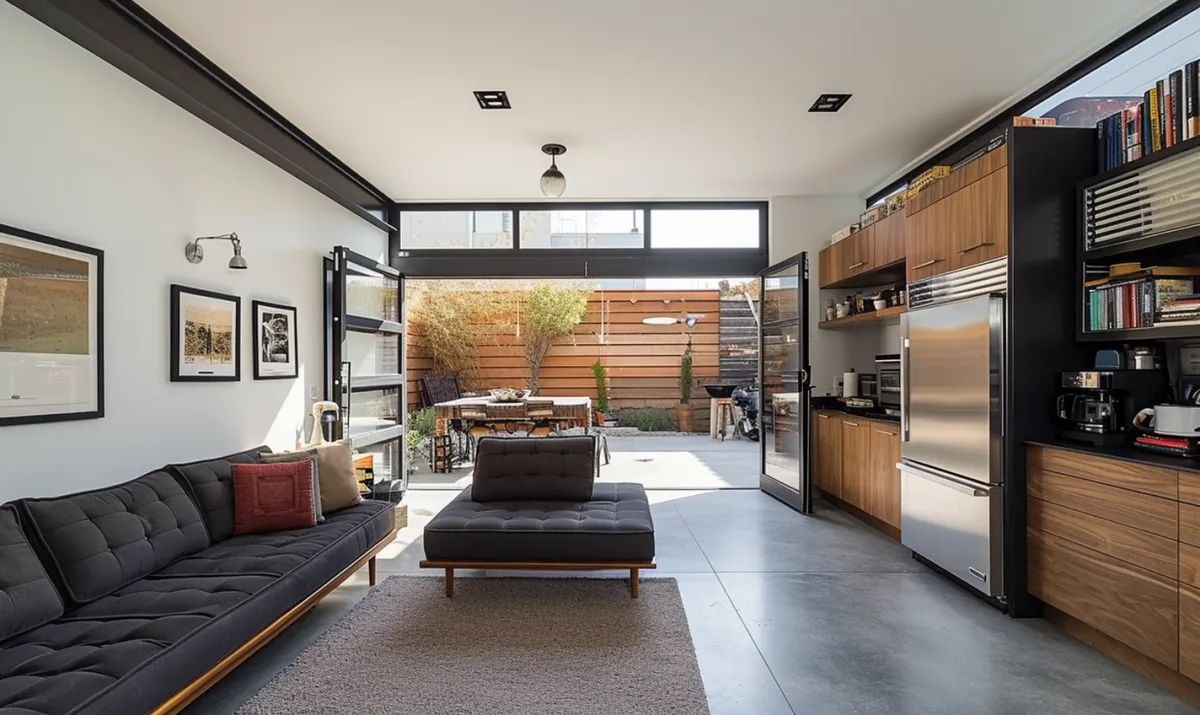
Converting a garage into a mini apartment is a fantastic way to make the most of your space and add value to your home. However, finding suitable storage solutions is one of the main challenges when creating a small apartment in a garage. As space is limited, maximizing every square inch of your apartment is crucial to ensure functionality and organization.
Utilize Vertical Space
One of the best ways to optimize storage in a small garage apartment is to utilize vertical space. Consider installing tall bookshelves or wall-mounted cabinets that reach the ceiling. This provides ample storage for books, décor items, or everyday essentials while using unused wall space.
Additionally, use vertical storage solutions such as hanging racks, pegboards, or hooks to store tools, bicycles, or sports equipment. This not only keeps your items organized but also helps to free up floor space.
Dual-Purpose Furniture
In a small garage apartment, every piece of furniture should serve a dual purpose to maximize storage. Opt for ottomans with hidden storage compartments, bed frames with built-in drawers, or coffee tables with shelves or cubbies.
Additionally, consider investing in modular furniture that can be rearranged and adapted to your changing needs. This flexibility allows you to optimize your space based on your activities and storage requirements.
Foldable and Compact Furniture
Consider incorporating foldable or compact furniture solutions if your garage apartment is limited in space. Folding chairs, drop-leaf tables, or collapsible desks can be easily stored when unused, creating more room for other activities.
Furthermore, consider using furniture with built-in storage compartments, such as storage ottomans or benches with hidden compartments. These provide a discreet and efficient way to store items while keeping your apartment clutter-free.
Creative Use of Nooks and Crannies
An advantage of converting a garage into a mini apartment is the presence of unique architectural features. Utilize nooks, alcoves, or odd corners creatively to create additional storage space.
Install floating shelves, hanging racks, or built-in shelving units in these areas to display and organize your belongings. These often overlooked spaces allow you to add character to your apartment while maximizing storage potential.
Remember, practical storage solutions can make or break the functionality and aesthetics of your small garage apartment. By utilizing vertical space, investing in dual-purpose and foldable furniture, and thinking creatively about your storage options, you can create a well-organized and visually appealing living space with plenty of room for all your belongings.
Considerations for Plumbing and Electrical in Your Garage Conversion
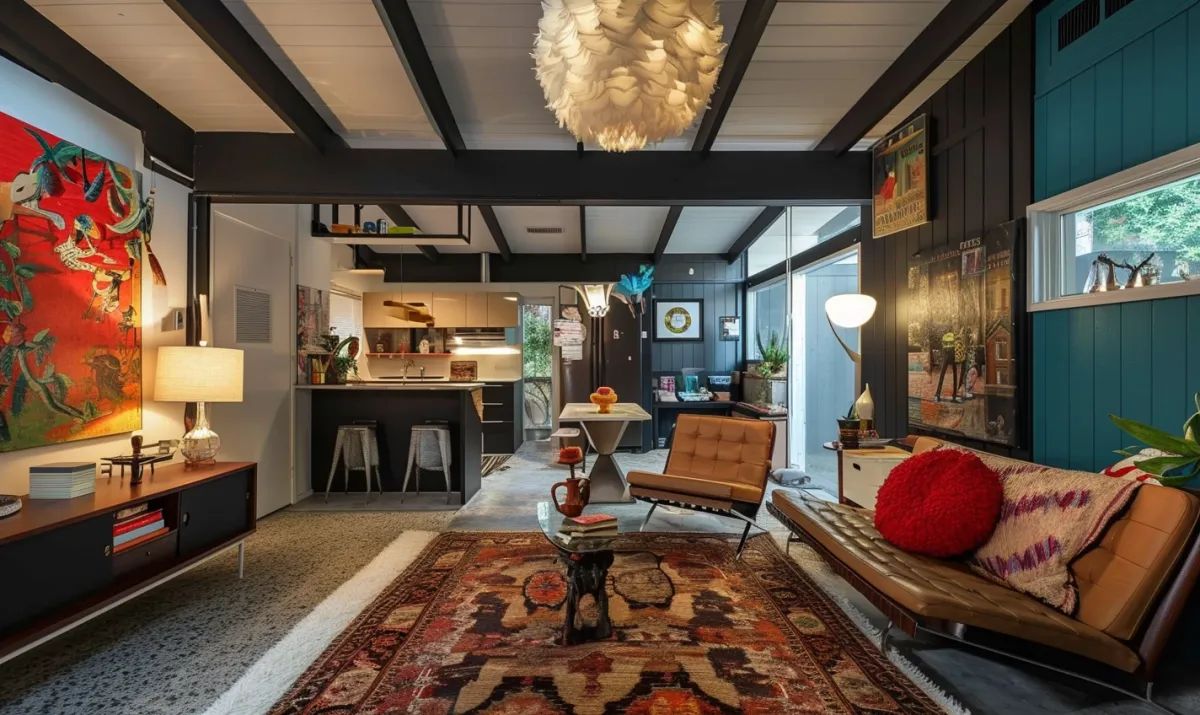
When converting a garage into a mini apartment, it’s crucial to consider the plumbing and electrical aspects of the project. These elements are essential for creating a comfortable and functional living space. Here are some key considerations to keep in mind:
Assessing Existing Plumbing and Electrical Systems
Before starting any work, evaluating your garage’s current plumbing and electrical systems is essential. Determine if they are up to code and can support the needs of a residential space. Consult a professional plumber and electrician to ensure compliance and safety if necessary.
Planning the Layout
When converting your garage, you must plan the layout of the plumbing fixtures and electrical outlets. Consider the placement of sinks, toilets, showers, and other water fixtures. Also, plan for sufficient electrical outlets, lighting fixtures, and switches to accommodate your needs.
Upgrading Electrical Wiring
Older garages may often have outdated electrical wiring that is unsuitable for modern living. It’s crucial to upgrade the electrical system to meet building codes and ensure safe and reliable power distribution. This may involve installing a new electrical panel, wiring, and outlets.
Plumbing Considerations
Installing plumbing fixtures in a garage conversion requires careful consideration. If your garage is not connected to the main plumbing lines in your home, you may need to install a separate sewer line and connect it to the city’s sewer system. Additionally, plan for proper ventilation and drainage to prevent moisture-related issues.
Water Heater Installation
Since a mini apartment typically includes a bathroom and kitchen, it’s essential to consider the installation of a water heater. Determine the appropriate size and type of water heater based on the demand and available space. Consider options such as tankless water heaters to save on space and energy.
Converting a garage into a mini apartment requires careful attention to plumbing and electrical details. You can create a comfortable and functional living space by evaluating existing systems, planning the layout, upgrading electrical wiring, considering plumbing requirements, and installing a suitable water heater. Remember to consult with professionals and ensure compliance with local building codes to guarantee the safety and quality of your garage conversion.
Creating Privacy and Soundproofing in Your Mini Apartment
When converting a garage into a mini apartment, one of the critical considerations is creating privacy and soundproofing. After all, you want your new living space to provide a peaceful oasis away from the hustle and bustle of the outside world. Here are a few tips to help you achieve just that:
Insulate the Walls:
Proper insulation is crucial for both privacy and soundproofing. Install insulation materials within the walls, such as fiberglass or foam boards, to minimize noise transfer and maintain temperature control. This will help create a more secluded and comfortable living environment.
Seal Any Gaps:
To prevent sound leakage and maintain privacy, it’s essential to seal any gaps or cracks in the walls, doors, and windows. Apply weatherstripping or caulking to fill these openings, ensuring a tight seal that removes unwanted noise.
Install Solid Doors:
The type of doors you choose can significantly impact privacy and soundproofing in your mini apartment. Opt for solid doors rather than hollow ones, as they provide better insulation and minimize noise transmission. Additionally, consider a door sweep at the base to reduce gaps through which sound can travel further.
Hang Heavy Curtains or Blinds:
Treating windows with heavy curtains or blinds can help block out external noise and add an extra layer of privacy. Choose thick, lined curtains or blinds made of noise-absorbing fabrics to maximize their soundproofing capabilities.
Use Acoustic Panels:
If you’re particularly concerned about soundproofing, consider installing acoustic panels on the walls and ceiling. These specially designed panels absorb sound, reducing echoes and reverberation within the space.
Arrange Furniture Strategically:
The furniture layout can also impact the privacy and soundproofing of your mini apartment. Arrange bulky items, such as bookcases or sofas, along shared walls to help absorb sound and block noise from neighboring areas.
Soundproof the Floor:
If your garage conversion involves adding a new floor, consider using soundproofing materials such as cork underlayment or carpet padding. These can help reduce sound transmission to the level below and create a quieter living space.
Creating privacy and soundproofing in your mini apartment allows you to transform your garage into a tranquil retreat that provides peace amid your busy life.
The Importance of Proper Ventilation in Garage Conversions
Many factors must be considered when converting a garage into a mini apartment. Each aspect is crucial in creating a comfortable and livable space, from layout design to insulation. However, one aspect that should never be overlooked is proper ventilation.
A Breath of Fresh Air
Ventilation is vital in any living space, and garage conversions are no exception. Since garages are not typically designed for habitation, they often lack proper airflow. Without adequate ventilation, the air inside the converted space can become stale, humid, and potentially hazardous.
Proper ventilation helps to address several crucial points:
- Improves indoor air quality by removing pollutants, odors, and excess moisture.
- Prevents the buildup of harmful gases such as carbon monoxide.
- Reduces the risk of mold and mildew growth.
- Promotes a healthier living environment.
Options for Ventilation
There are various options available to ensure proper ventilation in your garage conversion. Consider the following:
- Windows: Installing windows allows for natural airflow and sunlight. Opt for windows that can be opened and closed quickly.
- Ventilation Fans: These come in various types, such as exhaust fans and whole-house fans, which help circulate air and remove stale air from the space.
- Ductwork: Connecting the garage conversion to the existing HVAC system is another option to ensure proper airflow throughout the space.
Your Comfort Zone
Proper ventilation improves the air quality and contributes to the overall comfort of your mini apartment. It helps regulate temperature and reduces humidity, creating a more pleasant living environment.
Remember, addressing ventilation needs when converting a garage into a mini apartment is not just about meeting building codes; it’s about ensuring your well-being and enjoyment of the space.
Utilizing Outdoor Space for Your Garage Apartment
When converting a garage into a mini apartment, it’s essential to consider how you can make the most of your outdoor space. By utilizing the area outside your new living quarters, you can create additional functional and enjoyable spaces that enhance the overall appeal of your garage apartment. Here are some ideas to help you make the most out of your outdoor area:
Create a Cozy Patio
Transforming a portion of your yard or driveway into a patio area is a fantastic way to extend your living space and enjoy the outdoors. Place some comfortable outdoor furniture, such as a table and chairs or a cozy lounge set, to create a relaxing spot to unwind or entertain guests. Add some potted plants or hanging baskets to bring a touch of nature to your patio and make it feel more inviting.
Add Greenery and Privacy
Landscaping your outdoor space can beautify your surroundings and provide privacy for your garage apartment. Planting hedges, shrubs, or tall potted plants around the perimeter of your outdoor area can act as a natural barrier, creating a sense of seclusion. Incorporating colorful flowers and plants can add vibrancy and freshness to your outdoor space.
Create an Outdoor Kitchen or Barbecue Area
If you enjoy cooking or hosting outdoor gatherings, consider installing an outdoor kitchen or barbecue area. This addition will allow you to prepare meals while enjoying the fresh air and sunshine. Include a grill, countertops, and a sink for convenience. You can also add seating options, such as a bar counter and stools, to create a casual dining area for your guests.
Add Storage Solutions
Maximize the functionality of your outdoor space by incorporating storage solutions. Install sturdy cabinets or shelves to store gardening tools, sports equipment, or outdoor supplies. This will help you keep your garage apartment clutter-free while providing easy access to the items you need for outdoor activities.
Create an Alluring Pathway
Elevate the aesthetics of your outdoor space by creating a pathway that leads to your garage apartment. Use materials such as stone or gravel to design a path that complements the overall style of your mini apartment. Add stepping stones, solar-powered lights, or well-placed spotlights to enhance the visual appeal and make your pathway functional at night.
By considering these outdoor space utilization ideas, you can truly maximize the potential of your garage apartment. The possibilities are endless, whether you want to create a cozy patio, a private oasis, or an inviting outdoor kitchen. Embrace the flexibility that converting a garage offers and transform the inside and outside of your mini apartment into a place you’ll love to call home.
Conclusion
In conclusion, converting a garage into a mini apartment is a brilliant solution for maximizing space and creating additional living areas in your home. This renovation project offers numerous benefits, from providing additional living space for family members or guests to generating rental income.
You can transform your garage into a functional, stylish, and comfortable living space that perfectly suits your needs by repurposing your garage. With careful planning and design, you can optimize the layout to include essential living areas such as a bedroom, bathroom, kitchenette, and living room.
Not only does converting a garage into a mini apartment allow you to make the most of existing space, but it also adds value to your property. This adaptable living space can increase the marketability and appeal of your home, making it an attractive option for potential buyers.
Moreover, creating a mini apartment in your garage can be a cost-effective alternative to building a traditional extension or relocating to a more extensive property. It saves you from the expenses associated with construction, permits, and moving costs. Instead, you can utilize the existing infrastructure of your garage and transform it into a functional and charming living space.
Frequently Asked Questions (FAQs)
Q: What is a mini apartment?
A mini apartment is a small living space that typically includes essential amenities such as a bedroom, bathroom, kitchenette, and living area, all within a compact floor plan.
Q: Why convert a garage into a mini apartment?
Converting a garage into a mini apartment is a popular choice for homeowners. It can provide additional living space, increase the property’s value, and offer an excellent opportunity for rental income or a dedicated space for guests or elderly family members.
Q: What factors should I consider before converting a garage into a mini apartment?
Before undertaking a garage conversion, you should check local building regulations, evaluate the structural integrity of the garage, consider parking alternatives, and determine the budget and timeline for the project.
Q: Do I need planning permission to convert my garage into a mini apartment?
The need for planning permission may vary based on your location and the specific regulations in your area. In some cases, you may need to obtain planning permission, especially if you plan to make significant alterations to the external structure of the building or if you live in a designated conservation area. It is best to consult with your local authorities or seek professional advice to understand the requirements specific to your situation.
Q: Do I need to follow specific building codes for a garage conversion?
You would typically need to adhere to local building codes when converting a garage into a mini apartment. These codes usually dictate the minimum room size, ceiling height, insulation requirements, proper ventilation, and emergency egress options. It is crucial to check these requirements with your local authorities or consult a professional contractor or architect familiar with the local building regulations.
Q: How can I maximize the space in a converted garage?
To maximize space in a converted garage, consider using built-in storage solutions, incorporating multifunctional furniture, using light colors to create an airy feel, and utilizing vertical wall space for shelving or hanging items. Additionally, clever utilization of space-saving techniques like installing a Murphy bed or utilizing foldable furniture can help optimize the available area.